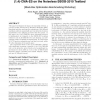Free Online Productivity Tools
i2Speak
i2Symbol
i2OCR
iTex2Img
iWeb2Print
iWeb2Shot
i2Type
iPdf2Split
iPdf2Merge
i2Bopomofo
i2Arabic
i2Style
i2Image
i2PDF
iLatex2Rtf
Sci2ools
GECCO
2010
Springer
2010
Springer
Investigating the impact of sequential selection in the (1, 4)-CMA-ES on the noiseless BBOB-2010 testbed
This paper investigates the impact of sequential selection, a concept recently introduced for Evolution Strategies (ESs). Sequential selection performs the evaluations of the different candidate solutions sequentially and concludes the iteration immediately if one offspring is better than the parent. In this paper, the (1,4s )-CMA-ES, where sequential selection is implemented, is compared on the BBOB-2010 noiseless testbed to the (1,4)-CMA-ES. For each strategy, an independent restart mechanism is implemented. A total budget of 104 D function evaluations per trial has been used, where D is the dimension of the search space. The experiments show for the (1,4s )-CMA-ES a statistically significant worsening compared to the (1,4)-CMA-ES only on the attractive sector function but a significant improvement by about 20% on 5 out of the 24 BBOB-2010 functions (sphere, separable and rotated ellipsoid, discus, and sum of different powers). Categories and Subject Descriptors
1 | 4s )-CMA-ES | GECCO 2010 | Optimization | Sequential Selection |
| Added | 12 Oct 2010 |
| Updated | 12 Oct 2010 |
| Type | Conference |
| Year | 2010 |
| Where | GECCO |
| Authors | Anne Auger, Dimo Brockhoff, Nikolaus Hansen |
Comments (0)

